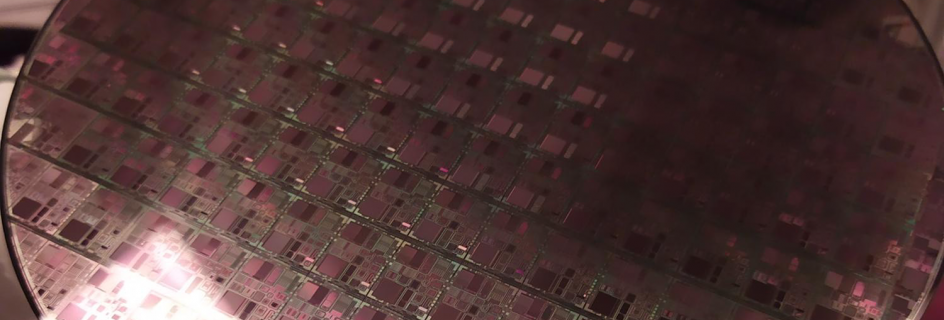Post date:
Engineers have succeeded in creating a new form of memory technology which can ‘remember’ data in a similar way to synapses in the human brain.
The breakthrough means that electronic devices such as mobile phones could potentially store and process much larger quantities of data than previously possible, without relying on the user to delete old information or use data-intensive cloud storage systems.
The study was conducted by a team led by Professor Themis Prodromakis, the University of Edinburgh’s new Regius Chair of Engineering and Director of the Centre for Electronics Frontiers.
Data demands
Across the world, we rely on computers, mobile phones and other electronic devices which produce and store vast amounts of data. Every day globally, we generate about 2.5 quintillion bytes of data – equivalent to around five million household hard disks of storage.
Our demand for electronic devices that can instantly store and process huge quantities of information are only set to increase with the advent of data-driven technologies such as the Internet of Things (IoT) and artificial intelligence.
These technologies, however, come with a growing environmental cost, due to their intensive use of energy and natural resources. The electronics industry is therefore increasingly trying to find more innovative and less environmentally impactful ways to solve electronic memory storage issues.
A bio-inspired solution
While a traditional solution has been to erase old data to free up space in electronic devices, a team of researchers based at the universities of Edinburgh and Southampton have turned to the biological memory for inspiration.
Our brains operate in a complex way to remember information, allowing us to repeatedly write new memories atop old ones in a “palimpsest” fashion – the name given to historical manuscripts on which later writing are superimposed on earlier writing.
Our brains have this extraordinary ability thanks to biochemical processes found in biological synapses, which allow them to learn quickly and continuously – at multiple timescales – without forgetting old memories.
“Memristor” technologies
These observations inspired the researchers to create artificial synaptic networks mimicking the biological brain, using emerging nanoscale memory technologies known as “memristors” – short for “memory resistor”.
In their study, recently published in the journal Science Advances, the researchers showed a new way to configure artificial neural networks that use this technology, which means they could achieve equivalent learning and memorising abilities to biological systems.
The artificial synapses created by the researchers work in an analogue fashion – using continuous electronic signals of varying amplitudes, rather than the binary signals used by modern digital electronics. This enables the synapses to “remember” previously stored memories even after new ones are stored on top of them – much like a palimpsest.
Testing the technology
In the study, the researchers tested out the memory abilities of their solution by subjecting it to “spiking memory events” in the form of electric signals like those which transmit information across the human brain, while also asking them to continuously learn new and unrelated memories.
In conventional artificial neural networks like those found in modern AI processors, this interference would cause older memories to be permanently erased. The memristive networks, by contrast, are constructed using multiple independent memory mechanisms, allowing one mechanism to retain old memories even after another temporarily writes new ones.
The researchers have demonstrated that their prototypes can remember old data over a long period, even after being overloaded with information that would cause “catastrophic forgetting” in conventional electronic devices.
World-first
This is the first time that so-called “palimpsest memory consolidation” has been demonstrated in electronic hardware, unlocking new possibilities for the electronics industry.
For example, it could help improve memory storage in hardware that operates in a “continuously-ON” fashion, like the Mars rover which constantly takes in data about its ever-changing environment, or a smartphone intelligently adapting to the needs of its owner.
The ability of electronic devices to learn and retain information locally – that is, within the device itself, as in so-called “edge” computing – offers a promising alternative to cloud computing services which store data on the internet, and rely on powerful internet bandwidths for transferring data.
The researchers hope the new technology will help democratise access to AI technologies among the wider public.
Revolutionising storage
Christos Giotis, lead author and PhD candidate at the Centre for Electronics Frontiers, commented:
“We are very happy with this outcome. It shows how research in engineering can be inspired by biology and help to advance AI and a wide range of practical applications.”
Professor Prodromakis added:
“Who hasn’t suffered from the pain of their phones or USB sticks running out of storage and going through the dilemma of which photos or music they should delete for making space for new memories and data to be stored?”
“Our lab has been developing memristive technologies and AI hardware for over a decade now. This research, however, required a complete rethink of how memory can be transcribed using the dynamics of complex electrochemical mechanisms and comparing those to the learning processes taking place in real biological synapses.”
“We are very excited with the prospects this technology could bring to modern societies.”



